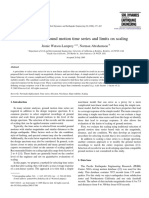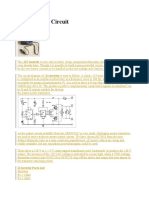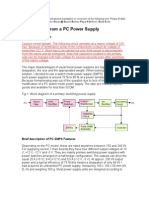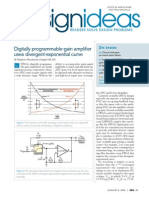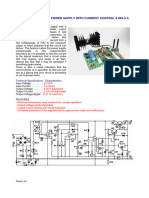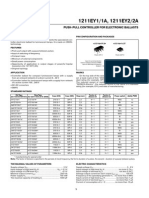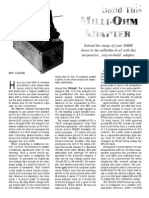Circuit Diagram
Circuit Diagram
Uploaded by
Earl Jhoy EstreraCopyright:
Available Formats
Circuit Diagram
Circuit Diagram
Uploaded by
Earl Jhoy EstreraCopyright
Available Formats
Share this document
Did you find this document useful?
Is this content inappropriate?
Copyright:
Available Formats
Circuit Diagram
Circuit Diagram
Uploaded by
Earl Jhoy EstreraCopyright:
Available Formats
Circuit diagram:
Cheap 12V to 220V Inverter Circuit Diagram As the mark/space ratio (duty factor) of the 555 output is a long way from being 1:1 (50%), it is used to drive a D-type flip-flop produced using a CMOS type 4013 IC. This produces perfect complementary square-wave signals (i.e. in antiphase) on its Q and Q outputs suitable for driving the output power transistors. As the output current available from the CMOS 4013 is very small, Darlington power transistors are used to arrive at the necessary output current. We have chosen MJ3001s from the now defunct Motorola (only as a semi-conductor manufacturer, of course!) which are cheap and readily available, but any equivalent power Darlington could be used. These drive a 230 V to 2 9 V center-tapped transformer used backwards to produce the 230 V output. The presence of the 230 VAC voltage is indicated by a neon light, while a VDR (voltage dependent resistor) type S10K250 or S07K250 clips off the spikes and surges that may appear at the transistor switching points. The output signal this circuit produces is approximately a square wave; only approximately, since it is somewhat distorted by passing through the transformer. Fortunately, it is suitable for the majority of electrical devices it is capable of supplying, whether they be light bulbs, small motors, or power supplies for electronic devices. PCB layout:
PCB Layout For Cheap 12V to 220V Inverter Circuit Diagram COMPONENTS LIST Resistors R1 = 18k? R2 = 3k3 R3 = 1k R4,R5 = 1k?5 R6 = VDR S10K250 (or S07K250) P1 = 100 k potentiometer Capacitors C1 = 330nF C2 = 1000 F 25V Semiconductor T1,T2 = MJ3001 IC1 = 555 IC2 = 4013 Miscellaneous LA1 = neon light 230 V F1 = fuse, 5A TR1 = mains transformer, 2x9V 40VA (see text) 4 solder pins Note that, even though the circuit is intended and designed for powering by a car battery, i.e. from 12 V, the transformer is specified with a 9 V primary. But at full power you need to allow for a voltage drop of around 3 V between the collector and emitter of the power transistors. This relatively high saturation voltage is in fact a shortcoming common to all devices in Darlington configuration, which actually consists of two transistors in one case. Were suggesting a PCB design to make it easy to construct this project; as the component overlay shows, the PCB only carries the low-power, low-voltage components. The Darlington transistors should be fitted onto a finned anodized aluminum heat-sink using the standard insulating accessories of mica washers and shouldered washers, as their collectors are connected to the metal cans and would otherwise be short-circuited. An output power of 30 VA implies a current consumption of the order of 3 A from the 12 V battery at the primary side. So the wires connecting the collectors of the MJ3001s [1] T1 and T2 to the transformer primary, the emitters of T1 and T2 to the battery negative terminal, and the battery positive terminal to the transformer primary will need to have a minimum crosssectional area of 2 mm2 so as to minimize voltage drop. The transformer can be any 230 V to 2 9 V type, with an E/I iron core or toroidal, rated at around 40 VA. Properly constructed on the board shown here, the circuit should work at once, the only adjustment being to set the output to a frequency of 50 Hz with P1. You should keep in minds that the frequency stability of the 555 is fairly poor by todays standards, so you shouldnt rely on it to drive your radio-alarm correctly but is such a device very useful or
indeed desirable to have on holiday anyway? Watch out too for the fact that the output voltage of this inverter is just as dangerous as the mains from your domestic power sockets. So you need to apply just the same safety rules! Also, the project should be enclosed in a sturdy ABS or diecast so no parts can be touched while in operation. The circuit should not be too difficult to adapt to other mains voltages or frequencies, for example 110 V, 115 V or 127 V, 60 Hz. The AC voltage requires a transformer with a different primary voltage (which here becomes the secondary), and the frequency, some adjusting of P1 and possibly minor changes to the values of timing components R1 and C1 on the 555.
You might also like
- Mini Project Report (CLAP SWITCH)Document22 pagesMini Project Report (CLAP SWITCH)Om Prakash Singh100% (4)
- Slup083 PDFDocument7 pagesSlup083 PDFlu1agpNo ratings yet
- 12v DC To 220v AC Converter Circuit Using Astable MultivibratorDocument3 pages12v DC To 220v AC Converter Circuit Using Astable MultivibratorKïshörë0% (1)
- Selection of Ground Motion Time Series and Limits On ScalingDocument6 pagesSelection of Ground Motion Time Series and Limits On ScalingAbdelwahabNo ratings yet
- Inversor 12V To 220V InverterDocument3 pagesInversor 12V To 220V InverterWILLIAM MONTOYA VILLANo ratings yet
- Cheap 12V To 220V InverterDocument3 pagesCheap 12V To 220V InverterAnaar KaliNo ratings yet
- 12V InverterDocument3 pages12V InverterDikdik BudimanNo ratings yet
- Oscillator: How To Build An InverterDocument7 pagesOscillator: How To Build An InverterGopal Prasad BansalNo ratings yet
- 1.5v Battery ChargerDocument25 pages1.5v Battery ChargerJOHN BRICCO A. MATACSILNo ratings yet
- DC Power SupplyDocument4 pagesDC Power SupplyAnti CrazyNo ratings yet
- Amp TuburiDocument8 pagesAmp Tuburinicolae12100% (1)
- AtxDocument27 pagesAtxstefo.1100% (2)
- Converter 12 VDC To 230 Vac or Inverter - Power Supply CircuitsDocument2 pagesConverter 12 VDC To 230 Vac or Inverter - Power Supply CircuitsIkkasama NaguenneNo ratings yet
- x060309 PDFDocument5 pagesx060309 PDFlu1agpNo ratings yet
- 100 Watt InverterDocument11 pages100 Watt InverterscribdexpressNo ratings yet
- EDN Design Ideas 2009Document144 pagesEDN Design Ideas 2009chag195675% (4)
- Invertor 12-220vDocument3 pagesInvertor 12-220vBorcan Cristi100% (4)
- Best of Design Ideas - Volume 2Document18 pagesBest of Design Ideas - Volume 2ableseaman100% (4)
- Electronic Transformer For 12 V Halogen LampDocument15 pagesElectronic Transformer For 12 V Halogen LampWin KyiNo ratings yet
- 13.8 V - 15 A From A PC Power Supply PDFDocument7 pages13.8 V - 15 A From A PC Power Supply PDFcolorado wildernessNo ratings yet
- Fuente de 12 VDC Sin TransformadorDocument16 pagesFuente de 12 VDC Sin TransformadorElvis Fernando Ñaupari ChahuaNo ratings yet
- Projeto Amplificador de Potência 125W C/ MJ15003Document4 pagesProjeto Amplificador de Potência 125W C/ MJ15003Jesse JamesNo ratings yet
- 4 Simple Transformerless Power Supply Circuits Explained - Homemade Circuit ProjectsDocument24 pages4 Simple Transformerless Power Supply Circuits Explained - Homemade Circuit ProjectsK. RAJA SEKARNo ratings yet
- 250 WATT Power Inverter: Power Small Appliances From Your Car or Any Other 12-Volt Source With Our 250-Watt InverterDocument3 pages250 WATT Power Inverter: Power Small Appliances From Your Car or Any Other 12-Volt Source With Our 250-Watt Invertertaner56No ratings yet
- DC To Ac Converter by Using 555 Timer ICDocument6 pagesDC To Ac Converter by Using 555 Timer ICAlfred Adukobirre Adukobilla0% (1)
- Transformador Electrnico para La Lmpara Del Halgeno 12cv 214Document5 pagesTransformador Electrnico para La Lmpara Del Halgeno 12cv 214billy_lxNo ratings yet
- EL Transf 12VDocument4 pagesEL Transf 12VmarjanchoNo ratings yet
- 0-30 VDC Stabilized Power Supply With Current Control 0.002-3 ADocument12 pages0-30 VDC Stabilized Power Supply With Current Control 0.002-3 Anmgaby21No ratings yet
- SMPS CKTDocument5 pagesSMPS CKTdkjena1No ratings yet
- X-10 Compatible Appliance ModuleDocument0 pagesX-10 Compatible Appliance ModuleburdinskiNo ratings yet
- DC To Ac InverterDocument7 pagesDC To Ac InverterMuhammad Anim AkashNo ratings yet
- AC Current Monitor by LM358Document14 pagesAC Current Monitor by LM358wlen2012No ratings yet
- Labvoeding 30 V 3 ADocument7 pagesLabvoeding 30 V 3 AOrnelio ReiphNo ratings yet
- Tired of Low Battery Voltage? Build A Step-Up DC-DC Converter!Document2 pagesTired of Low Battery Voltage? Build A Step-Up DC-DC Converter!ferreira_tomarNo ratings yet
- Amplificador de Bulbos de Bajo CostoDocument6 pagesAmplificador de Bulbos de Bajo CostoNaelectronic UONo ratings yet
- Analogue 1 ProjectDocument9 pagesAnalogue 1 ProjectCJ CHNo ratings yet
- 13.8 V 15 A From A PC Power SupplyDocument8 pages13.8 V 15 A From A PC Power SupplyTibor NemethNo ratings yet
- 300 Watt Power AmplifierDocument10 pages300 Watt Power AmplifiersasamajaNo ratings yet
- Circuit For Accurate RTD MeasurementsDocument7 pagesCircuit For Accurate RTD MeasurementsBruceNo ratings yet
- 40104diDocument6 pages40104dimariastalinNo ratings yet
- Milliohmetru AdapterDocument3 pagesMilliohmetru AdapterIliescu CristianNo ratings yet
- IND5Document14 pagesIND5Experimentonomen100% (1)
- Principles and Applications of The ICL7660 CMOS Voltage Converter PDFDocument10 pagesPrinciples and Applications of The ICL7660 CMOS Voltage Converter PDFPeter JordanNo ratings yet
- Build A Nixie Power SupplyDocument3 pagesBuild A Nixie Power SupplysoretenegroNo ratings yet
- Experiment No: DateDocument24 pagesExperiment No: DateChaitanya ShahNo ratings yet
- Auto Shut OffDocument5 pagesAuto Shut OffJuan Manuel Han MacNo ratings yet
- Electronics Code Lock Using One TransistorDocument18 pagesElectronics Code Lock Using One TransistorAnonymous TvXDUWDaol50% (2)
- Ust8Lab: &" .RR, R T,.t,. S,/. !, L/, D-GR . T F F,"',4i18' - #+..Document5 pagesUst8Lab: &" .RR, R T,.t,. S,/. !, L/, D-GR . T F F,"',4i18' - #+..GiancarloRichardRivadeneyraMirandaNo ratings yet
- Chapter-1 Objective: 1.1 Objective of The ProjectDocument23 pagesChapter-1 Objective: 1.1 Objective of The ProjectPrashanth CooldudeNo ratings yet
- 1211EU2 en PDFDocument4 pages1211EU2 en PDFAnonymous u5128WZ1KNo ratings yet
- Another Interesting Circuit From Burt Design PadDocument13 pagesAnother Interesting Circuit From Burt Design PadmoisesHolaNo ratings yet
- RF Controlled ApplianceDocument14 pagesRF Controlled ApplianceNEX456No ratings yet
- AN-2061 LM3445 A19 Edison Retrofit Evaluation Board: User's GuideDocument11 pagesAN-2061 LM3445 A19 Edison Retrofit Evaluation Board: User's GuideVanessaDDMNo ratings yet
- Milli Ohm AdapterDocument6 pagesMilli Ohm Adapteralexandru25No ratings yet
- Austin Isolation TransformerDocument9 pagesAustin Isolation TransformermithunprayagNo ratings yet
- A Voltage Inverter Circuit: Part Total Qty. Description SubstitutionsDocument3 pagesA Voltage Inverter Circuit: Part Total Qty. Description Substitutionsmateus98No ratings yet
- Fonte AjustavelDocument1 pageFonte AjustavelsgriliNo ratings yet
- Reference Guide To Useful Electronic Circuits And Circuit Design Techniques - Part 1From EverandReference Guide To Useful Electronic Circuits And Circuit Design Techniques - Part 1Rating: 2.5 out of 5 stars2.5/5 (3)
- Reference Guide To Useful Electronic Circuits And Circuit Design Techniques - Part 2From EverandReference Guide To Useful Electronic Circuits And Circuit Design Techniques - Part 2No ratings yet
- A Study On Brand Loyalty of Sportswear Among RunnersDocument24 pagesA Study On Brand Loyalty of Sportswear Among RunnersSyazaa OrangeNo ratings yet
- Lesson Plan in Physical Science I. ObjectivesDocument6 pagesLesson Plan in Physical Science I. ObjectivesRafaela Nemia Rafael100% (1)
- Introduction To Subsea Production SystemDocument42 pagesIntroduction To Subsea Production Systemmadonnite3781No ratings yet
- Nacelle - Who Is Responsible of What - ISIDocument24 pagesNacelle - Who Is Responsible of What - ISISurya Agung S N100% (3)
- Ethics - Assignment 1 - MubarakahDocument6 pagesEthics - Assignment 1 - MubarakahMubarakah JailaniNo ratings yet
- Fiber Characterization ReportDocument24 pagesFiber Characterization ReportEugene BeliankaNo ratings yet
- Unit II. Market AnalysisDocument15 pagesUnit II. Market AnalysisGiselle IslasNo ratings yet
- Material SelfDocument34 pagesMaterial SelfCrystal DecanoNo ratings yet
- WEIR - ENDURON VIBRATING SCREEN DiamondDocument12 pagesWEIR - ENDURON VIBRATING SCREEN DiamondJaneNo ratings yet
- Probset 1 SolutionsDocument3 pagesProbset 1 SolutionsSuncheon8114No ratings yet
- Fee LW2Document10 pagesFee LW2Артур КултышевNo ratings yet
- Joan B. Balbada: ObjectiveDocument3 pagesJoan B. Balbada: ObjectiveEric Paolo CipresNo ratings yet
- 04 CreepDocument58 pages04 CreepYousef Adel HassanenNo ratings yet
- 1st Year Half Book TestDocument43 pages1st Year Half Book Testumair talash100% (1)
- Defect Prevention TechniquesDocument229 pagesDefect Prevention TechniquesZarko AcimovicNo ratings yet
- Curriculum Vitae - Rajkumar Ravi (2023)Document6 pagesCurriculum Vitae - Rajkumar Ravi (2023)meghna6252No ratings yet
- Wall Colmonoy - Colmonoy 6 6PTA 6L TDS - July2021Document4 pagesWall Colmonoy - Colmonoy 6 6PTA 6L TDS - July2021Siddharth DasNo ratings yet
- Adding and Subtracting Fractions WorksheetDocument8 pagesAdding and Subtracting Fractions WorksheetShaimaa BakiaNo ratings yet
- Section 02 - MV & FansDocument2 pagesSection 02 - MV & FansthanzeroNo ratings yet
- Green University of Bangladesh Department of Computer Science and Engineering (CSE)Document3 pagesGreen University of Bangladesh Department of Computer Science and Engineering (CSE)HimelNo ratings yet
- ME310-Mechanics of Machines: SyllabusDocument3 pagesME310-Mechanics of Machines: SyllabusMuhammad Usman KhanNo ratings yet
- Zandra Pia Lariosa - Balak and Poems ManuscriptDocument4 pagesZandra Pia Lariosa - Balak and Poems ManuscriptZANDRA PIA LARIOSANo ratings yet
- MandateDocument1 pageMandatelesser9897No ratings yet
- Configuration Steps For Upload of Photo in Employee Mastere PA30Document9 pagesConfiguration Steps For Upload of Photo in Employee Mastere PA30Krishna Mohan VNo ratings yet
- Ch03 MetricDocument266 pagesCh03 MetricYep IdidthisNo ratings yet
- Barnaby Jack Autopsy ReportDocument15 pagesBarnaby Jack Autopsy ReportConnor Sheets100% (1)
- Purple HibiscusDocument32 pagesPurple Hibiscussehar jaggiNo ratings yet
- Will KymlickaDocument5 pagesWill KymlickaprathameshNo ratings yet
- DatasheetDocument1,524 pagesDatasheetFakhrurrozi AmranNo ratings yet



